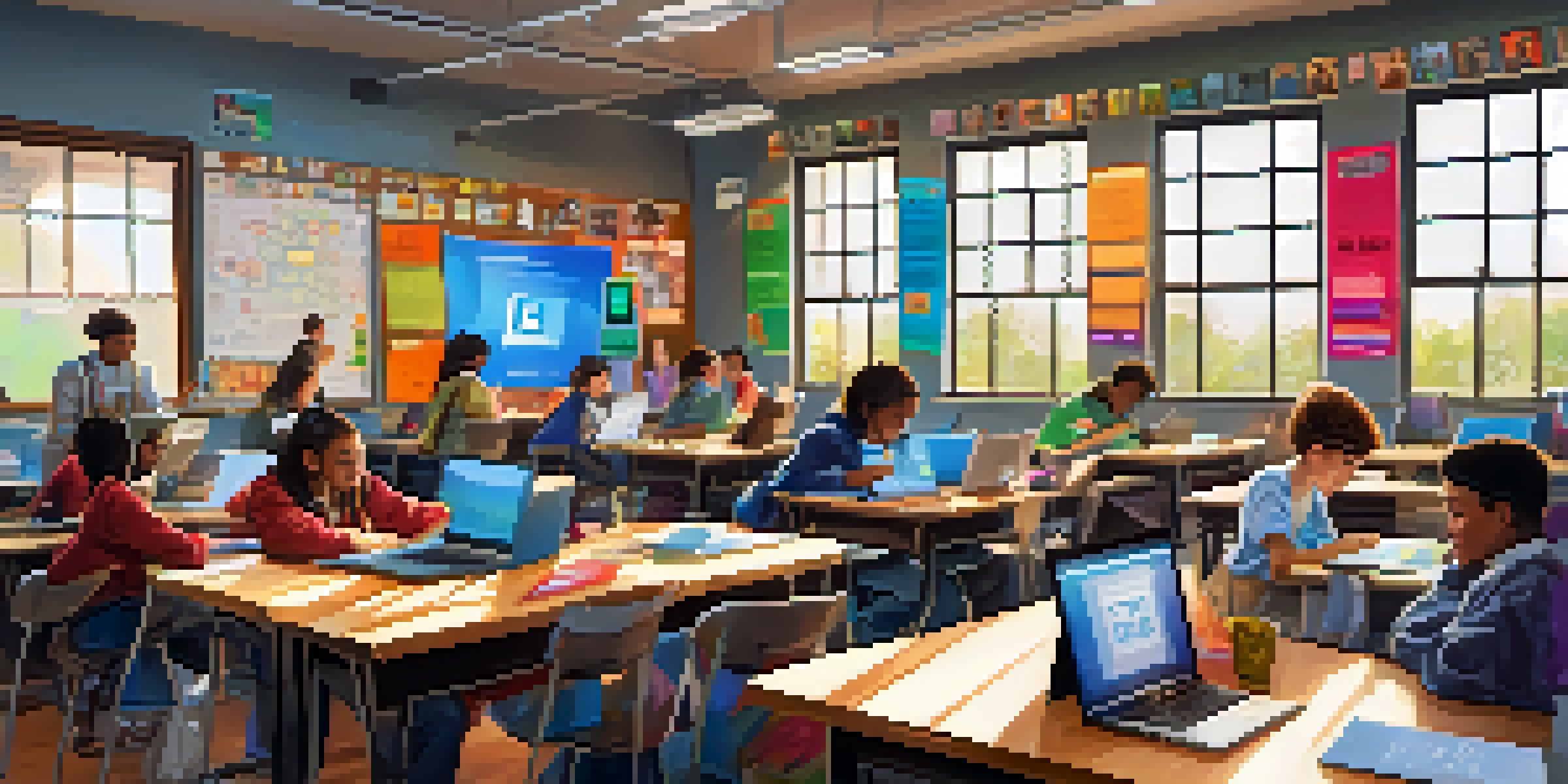Social Media for Peer Review and Feedback in Education

The Rise of Social Media in Education
In recent years, social media has become an integral part of our daily lives, including in educational environments. Platforms like Twitter, Facebook, and Instagram are not just for social interaction; they are powerful tools for learning and collaboration. Educators and students alike are beginning to tap into these platforms to facilitate discussions, share resources, and enhance the learning experience.
The great thing about social media is that it's a great equalizer. It gives a voice and a platform to anyone willing to engage.
This shift towards integrating social media into education opens up new avenues for peer review and feedback. Students can share their work with a wider audience, receiving critiques and suggestions in real-time. This immediacy can lead to deeper engagement and a more dynamic learning atmosphere, as students feel more connected to their peers.
Ultimately, the rise of social media in education reflects a broader trend towards collaboration and community-building. By embracing these tools, educators can create a more inclusive environment where feedback flows freely, enriching the learning process.
Benefits of Using Social Media for Peer Feedback
One of the primary benefits of using social media for peer feedback is accessibility. Students can engage with each other's work from anywhere, at any time, breaking down traditional barriers to communication. This flexibility allows for more spontaneous and authentic interactions, fostering a collaborative spirit among learners.

Additionally, social media can enhance the quality of feedback. Because students are often more comfortable communicating online, they may provide more honest and constructive critiques. This environment encourages open dialogue and the sharing of diverse perspectives, enriching the overall learning experience.
Social Media Enhances Learning
Integrating social media in education fosters collaboration, allowing students to engage deeply with feedback and learning materials.
Moreover, social media platforms often allow for multimedia sharing, enabling students to provide feedback through videos, images, or links. This variety can make the feedback process more engaging and informative, catering to different learning styles and preferences.
Creating a Safe Environment for Feedback
While social media offers many advantages, it's crucial to establish a safe environment for peer feedback. Students may feel hesitant to share their work or critique others if they fear negative reactions. Educators can mitigate this by setting clear guidelines for respectful communication and encouraging a culture of support.
Education is the most powerful weapon which you can use to change the world.
Moreover, privacy settings and group formations can help ensure that feedback remains constructive and focused. By creating closed groups or using platforms specifically designed for educational purposes, educators can maintain a level of control over the interactions taking place.
Ultimately, fostering a safe environment not only encourages participation but also promotes a growth mindset. When students feel secure in sharing their thoughts and ideas, they are more likely to engage deeply with the feedback process.
Choosing the Right Social Media Platforms
Not all social media platforms are created equal when it comes to peer feedback in education. Each platform has its unique features, strengths, and weaknesses that can influence how feedback is shared and received. For example, Twitter’s character limit encourages brevity and clarity, while Instagram allows for visual storytelling.
Educators should consider the specific needs of their students and the nature of the assignments when selecting a platform. For instance, if students are working on creative projects, a visually-oriented platform like Pinterest or Instagram might be most effective. Alternatively, if the focus is on textual analysis or written assignments, platforms like Facebook or dedicated forums may be more suitable.
Creating Safe Feedback Spaces
Establishing a secure environment for peer feedback encourages open dialogue and a supportive culture among students.
Ultimately, the choice of platform can significantly impact the quality and effectiveness of peer feedback. By aligning the platform with the learning objectives, educators can enhance student engagement and facilitate meaningful interactions.
Integrating Social Media into Existing Curriculum
Integrating social media into the existing curriculum may seem daunting at first, but it can be done seamlessly with a little planning. Educators can start small by incorporating social media assignments that align with current lesson plans. For example, students might share their research findings on Twitter or engage in discussions related to class topics on a private Facebook group.
Additionally, educators can create structured assignments that require students to give and receive feedback through social media. This could involve peer-reviewing each other's work before a final submission, thereby enhancing the quality of their projects while fostering collaboration.
By thoughtfully weaving social media into the curriculum, educators not only modernize their teaching practices but also prepare students for the digital world they are entering. This integration can lead to more relevant and engaging learning experiences.
Challenges and Solutions in Social Media Feedback
While using social media for peer feedback has its advantages, it also presents certain challenges. One common issue is the potential for miscommunication or misunderstandings, as tone and intent can often be lost in written text. To address this, educators can encourage students to use positive language and provide examples of constructive feedback.
Another challenge is the distraction factor; social media is designed to capture attention, which can lead students away from their primary tasks. Educators can combat this by setting specific guidelines for social media use during feedback sessions, ensuring that students remain focused on the task at hand.
Choosing Effective Platforms
Selecting the right social media platforms based on assignment needs can significantly improve the quality of peer feedback.
By proactively addressing these challenges, educators can create a more productive environment for social media-based peer feedback. Understanding the pitfalls allows for better preparation and ultimately leads to more effective learning experiences.
Future Trends in Social Media and Education
As technology continues to evolve, so too will the role of social media in education. Emerging trends suggest a growing emphasis on interactive and immersive experiences, such as virtual reality (VR) and augmented reality (AR) within social platforms. These advancements could transform how feedback is given, allowing for richer and more engaging interactions.
Moreover, the rise of AI-driven tools may streamline the feedback process, providing students with instant suggestions and resources based on their work. This could free up more time for personalized peer interactions, enhancing the overall feedback experience.

Ultimately, staying ahead of these trends will be crucial for educators looking to leverage social media effectively. By embracing innovation, they can continue to enhance peer review and feedback, making the learning process even more dynamic and impactful.